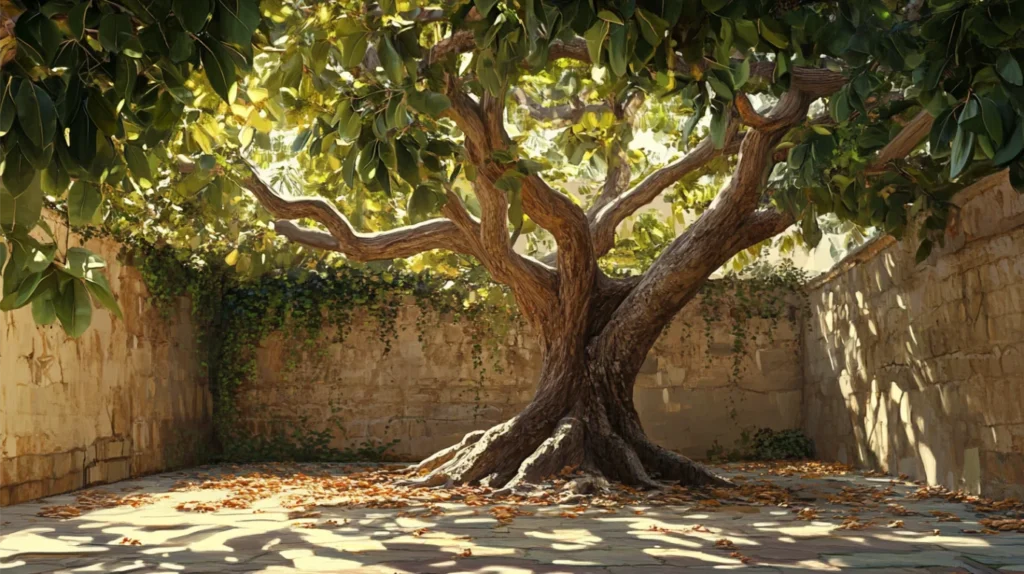
The fig tree holds a special place in many spiritual traditions, offering deep insights into personal growth, abundance, and spiritual awakening. As we explore the rich symbolism of this ancient tree, we’ll uncover its hidden wisdom and discover how it can guide us on our spiritual journey. From its lush leaves to its sweet fruit, the fig tree has much to teach us about patience, faith, and the cyclical nature of life.
In this post, we’ll delve into the spiritual significance of the fig tree, examining its role in various cultures and religious texts. We’ll also explore how its symbolism can be applied to our daily lives, helping us cultivate inner peace and spiritual abundance. Whether you’re a seasoned spiritual seeker or simply curious about the deeper meanings hidden in nature, the fig tree has something valuable to offer you.
Key Takeaways:
- The fig tree symbolizes spiritual growth, abundance, and patience
- It appears in many religious and cultural traditions, offering wisdom and guidance
- Understanding the fig tree’s symbolism can help us cultivate inner peace and spiritual abundance
The Fig Tree in Ancient Traditions

Throughout history, the fig tree has been revered in numerous cultures for its spiritual significance. In many ancient traditions, it was seen as a sacred tree, representing knowledge, fertility, and the connection between heaven and earth.
Biblical Significance
In the Bible, the fig tree appears several times, often as a symbol of spiritual health and abundance. One of the most famous mentions is in the Book of Matthew, where Jesus curses a barren fig tree, using it as a metaphor for spiritual fruitlessness. This story encourages us to reflect on our own spiritual productivity and the importance of bearing “good fruit” in our lives.
Eastern Philosophies
In Eastern traditions, the fig tree, particularly the Bodhi tree (a type of fig tree), holds great significance. It was under a Bodhi tree that Buddha is said to have achieved enlightenment, making it a powerful symbol of spiritual awakening and inner wisdom.
The Symbolism of Fig Tree Parts

Every part of the fig tree carries its own spiritual meaning, offering us a rich tapestry of symbolism to explore.
Leaves: Protection and Modesty
The large, lush leaves of the fig tree have long been associated with protection and modesty. In the biblical story of Adam and Eve, fig leaves were used to cover their nakedness after eating from the tree of knowledge. This symbolism reminds us of the importance of spiritual humility and the protection that comes from living a life aligned with our values.
Fruit: Abundance and Sweetness of Life
The fig fruit itself is a powerful symbol of abundance, fertility, and the sweetness of life. Its many seeds represent the potential for growth and new beginnings. When we see figs in our spiritual journey, it may be a sign that we’re entering a period of abundance or that we should focus on cultivating sweetness in our lives.
Roots: Grounding and Stability
While often unseen, the roots of the fig tree play a crucial role in its symbolism. They represent our connection to the earth, our ancestors, and our deepest values. Just as the fig tree’s roots provide stability and nourishment, our own spiritual roots give us the strength to weather life’s storms and continue growing.
Spiritual Lessons from the Fig Tree
The fig tree offers us many valuable lessons that we can apply to our spiritual lives. Let’s explore some of these teachings and how they can help us grow:
Patience and Timing
Fig trees are known for their slow growth and the time it takes for them to bear fruit. This teaches us the importance of patience in our spiritual journey. Are you feeling frustrated with your progress? Remember the fig tree, and trust that your efforts will bear fruit in due time.
Resilience and Adaptability
Fig trees can thrive in various climates and conditions, demonstrating remarkable resilience. This reminds us to stay flexible and adaptable in our spiritual practice, finding ways to grow and flourish even in challenging circumstances.
The Cyclical Nature of Growth
Like many trees, fig trees go through cycles of growth, dormancy, and renewal. This cyclical nature reflects our own spiritual journey, with its periods of intense growth, quiet reflection, and renewed energy. Embracing these cycles can help us maintain balance and avoid burnout.
Cultivating Your Inner Fig Tree
Now that we’ve explored the rich symbolism of the fig tree, how can we apply these lessons to our own lives? Here are some practical ways to cultivate your inner fig tree:
- Practice patience: When working towards a goal, remind yourself of the fig tree’s slow but steady growth. Trust the process and avoid rushing your spiritual development.
- Nurture your roots: Take time to connect with your core values and beliefs. Meditate, journal, or engage in practices that help you feel grounded and centered.
- Embrace cycles: Recognize that your spiritual journey will have ups and downs. Instead of fighting against these natural cycles, learn to flow with them and find value in each phase.
- Seek abundance: Look for ways to cultivate abundance in your life, not just materially, but spiritually and emotionally as well. Practice gratitude and generosity to amplify this energy.
- Prune when necessary: Just as a fig tree sometimes needs pruning to stay healthy, be willing to let go of beliefs or habits that no longer serve your spiritual growth.
Fig Tree Wisdom in Daily Life
The symbolism of the fig tree isn’t just for abstract spiritual concepts – it can offer practical guidance for our everyday lives. Here’s how you can apply fig tree wisdom to common life situations:
Career and Personal Growth
Think of your career as a fig tree. It takes time to grow and bear fruit, but with patience and consistent care, it can flourish. Are you nurturing your professional skills and relationships? Are you giving yourself enough time to see results?
Relationships
Like the intertwining branches of a fig tree, our relationships require support and care to thrive. Are you providing a nurturing environment for your relationships to grow? Are you patient with others as they go through their own growth processes?
Personal Challenges
When facing difficulties, imagine yourself as a resilient fig tree, bending but not breaking in the wind. How can you stay grounded while remaining flexible in the face of challenges?
Fig Tree Meditation
To deepen your connection with the spiritual symbolism of the fig tree, try this simple meditation:
Fig Trees in Various Spiritual Traditions
To further appreciate the widespread significance of the fig tree, let’s explore its role in different spiritual traditions:
| Tradition | Fig Tree Significance |
|---|---|
| Christianity | Symbol of Israel, spiritual fruitfulness |
| Buddhism | Bodhi tree of enlightenment |
| Hinduism | Associated with fertility and the goddess Lakshmi |
| Islam | Mentioned in the Quran as a blessed tree |
| Ancient Egypt | Symbol of life and abundance |
| Greek Mythology | Sacred to Dionysus, god of fertility and wine |
This table illustrates the universal appeal and spiritual importance of the fig tree across cultures and religions.
Embracing the Fig Tree’s Lessons
As we conclude our exploration of the spiritual meaning of the fig tree, take a moment to reflect on how its symbolism resonates with you. Which aspects of the fig tree’s wisdom speak most strongly to your current life situation? Perhaps it’s the call for patience, the reminder of life’s cycles, or the promise of abundance.
Remember, like the fig tree, your spiritual growth is a journey that unfolds over time. Be patient with yourself, stay rooted in your values, and trust that your efforts will bear sweet fruit. As you go about your day, carry the image of the fig tree with you – a living symbol of resilience, abundance, and spiritual awakening.
What lessons from the fig tree will you apply to your life today? How can you nurture your inner fig tree and cultivate a more abundant, spiritually rich existence? The answers lie within you, waiting to blossom like the sweet fruit of the fig tree.





